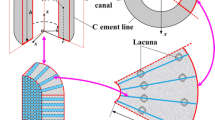Abstract
When load is applied to bone, it deforms and causes fluid pressure to build up in bone. The pressure gradient between different portions of the bone microcnannels drives fluid flow through them. This kind of bone fluid flow can induces the streaming potentials which are considered to play a role for bone remodeling. Aimed to determine the impact of ribbed rough inner surfaces of the microchannels on the streaming potentials, streaming potentials were measured as bone fluid flowed through the mcrospaces of thin cylinder bone samples under different pressure loading rates. The results show that the streaming potentials decrease with the increase of the pressure loading rates. A digital simulation calculation was performed and the results demonstrated that there were turbulent flows near the inner wall surfaces, which making the streaming potentials smaller in bone microchannels.
Similar content being viewed by others
References
Currey J D. The many adaptations of bone. J Biomech, 2003, 36(10): 1487–1495
Ahna A C, Grodzinskyc A J. Relevance of collagen piezoelectricity to “Wolff’s Law”: A critical review. Med Eng Phys, 2009, 31(7): 733–741
Burger E H, Klein-Nulend J, Smit T H. Strain-derived canalicular fluid flow regulates osteoclast activity in a remodelling osteon—a proposal. J Biomech, 2003, 36(10): 1453–1459
Ryan C R, Henry J D. From streaming potentials to shear stress: 25 years of bone cell mechanotransduction. J Orth Res, 2009, 27(2): 143–149
Pienkowski D, Pollack S R. The origin of stress-generated potentials in fluid-saturated bone. J Orth Res, 1983, 1(1): 30–41
Lemaire T, Naïli S, Rémond A. Study of the influence of fibrous pericellular matrix in the cortical interstitial fluid movement with hydroelectrochemical effects. J Biomech Eng, 2008, 130(1): 1–11
Cowin S C. Bone poroelasticity. J Biomech, 1999, 32(3): 217–238
Anderson J C, Eriksson C. Electrical properties of wet collagen. Nature, 1968, 218(5137): 166–168
Hong J W, Ko S O. Intraosseous pressure and strain generated potential of cylindrical bone samples in the drained uniaxial condition for various loading rates. J Mater Sci: Mater Med, 2008, 19(7): 2589–2594
Guzelsu N, Wienstien C, Kotha S P. A new streaming potential chamber for zeta potential measurements of particulates. Rev Sci Inst, 2010, 81(1): 1–6
Qin Y X, Lin W, Rubin C. The pathway of bone fluid flow as defined by In vivo intramedullary pressure and streaming potential measurements. Ann Biomed Eng, 2002, 30(5): 693–702
Lemaire T, Naïli S, Rémond A. Multiscale analysis of the coupled effects governing the movement of interstitial fluid in cortical bone. Biomech Model Mechan, 2006, 5(1): 39–52
Zhu J, Davidson C, Xuan X. Flow rate-modified streaming effects in heterogeneous microchannels. Microfluid Nanofluid, 2008, 5(6): 733–740
Gururaja S, Kim H J, Swan C C, et al. Modeling deformation-induced fluid flow in cortical Bone’s canalicular-lacunar system. Ann Biomed Eng, 2005, 33(1): 7–25
Mak A F T, Zhang J D. Numerical simulation of streaming potentials due to deformation-induced hierarchical flows in cortical bone. J Biomech Eng, 2001, 123(1): 66–70
Quenneville E, Binette J S, Garon M, et al. Fabrication and characterization of nonplanar microelectrode array circuits for use in arthroscopic diagnosis of cartilage diseases. IEEE Trans Biomed Eng, 2004, 51(12): 2164–2173
Garon M, Legare A, Guardo R, et al. Streaming potentials maps are spatially resolved indicators of amplitude, frequency and ionic strength dependant responses of articular cartilage to load. J Biomech, 2002, 35(2): 207–216
Xu L Y, Hou Z D. Influence of loading rate on streaming potentials in Bone. Exp Mech, 2009, 24(4): 320–326
Author information
Authors and Affiliations
Corresponding author
Rights and permissions
About this article
Cite this article
Xu, L., Hou, Z. & Wang, H. Investigation of pressure loading rates on streaming potentials in bone. Sci. China Technol. Sci. 54, 1376–1381 (2011). https://doi.org/10.1007/s11431-011-4399-8
Received:
Accepted:
Published:
Issue Date:
DOI: https://doi.org/10.1007/s11431-011-4399-8




